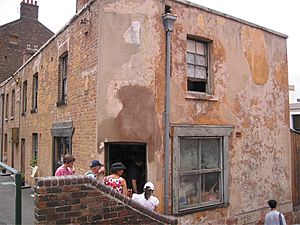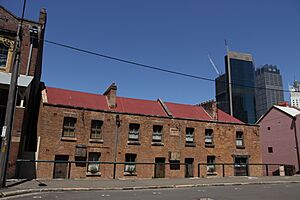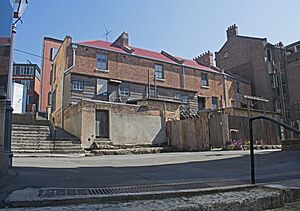Susannah Place facts for kids
Quick facts for kids Susannah Place |
|
|---|---|
 |
|
| Location | 58–64 Gloucester Street, The Rocks, City of Sydney, New South Wales, Australia |
| Built | 1844 |
| Architectural style(s) | Victorian Georgian |
| Governing body | Sydney Living Museums |
| Owner | Property NSW |
| Official name: Susannah Place; Susannah Place Museum; Susannah Terrace | |
| Type | State heritage (built) |
| Designated | 10 December 1999 |
| Reference no. | 1310 |
| Type | Terrace |
| Category | Residential buildings (private) |
| Lua error in Module:Location_map at line 420: attempt to index field 'wikibase' (a nil value). | |
Susannah Place is a special group of old houses and a former shop in The Rocks, a historic area in Sydney, Australia. It was built way back in 1844. Today, it's known as the Susannah Place Museum.
This place is like a time capsule! It shows us how people lived for over 160 years, especially working-class families in the city. People lived here until 1990, and now it's a museum managed by Sydney Living Museums. It's so important that it was added to the New South Wales State Heritage Register in 1999.
Contents
A Glimpse into the Past: Susannah Place History
Who Owned Susannah Place?
The land where Susannah Place stands has a long and interesting history. In the early 1800s, two men, William Walsh and Dennis Conway, both had buildings on the site. There was even an inn called The Duke Wellington here!
Later, in 1834, after both men had passed away, Conway's grandson, John Norman, argued that the land was his. He won the case! But then, Harriet Walsh, the widow of William Walsh Junior, bought the site. She faced money problems and had to sell it to James Byrne, a former convict, in 1835.
Building the Terraces
In 1842, James Byrne's wife, Sarah, had to sell the land. Edward Riley bought it. By 1844, the old buildings were gone, and four new houses were built. These are the houses we know today as Susannah Place. It's believed Edward Riley built them.
Edward and his wife Mary came to Sydney in 1838. They brought their niece, Susannah Sterne, with them. The houses are named after her! It's amazing that Edward, an immigrant, became the owner of four houses so quickly. Mary Riley owned the houses for almost 30 years after Edward died in 1853. She was a steady presence in the neighbourhood.
Life in the Houses: Water, Sewers, and Changes
During Mary Riley's time, Susannah Place likely got running water and a sewer connection. This was a big deal for comfort and health! After Mary passed away, her "grand-daughter" Mary Ann Hensley inherited the shop and one house. Mary Ann and her husband, John Finnegan, ran the grocery shop for a short time.
In 1900, the government took over the area after a plague outbreak. This didn't change who lived in the houses much. In the early 1900s, the streets around Susannah Place were changed. Gloucester Street was raised, and the backyards of some houses were made bigger.
Saving Susannah Place from Demolition
By the 1970s, the government agency in charge thought about knocking down Susannah Place. They believed the buildings were old and no longer useful. But the people living there and local community groups had other ideas!
They started a "Green Ban," which meant workers refused to demolish the buildings. This was a huge community effort to save the historic homes. One family, the Marshalls, stayed in their house until 1990, acting as unofficial caretakers.
In 1986, the Historic Houses Trust of New South Wales became interested in Susannah Place. The Premier of NSW, Neville Wran, said it was very important to the state's history. Work began in 1987 to fix up and preserve the buildings.
By 1992, the main repairs were finished, costing $250,000. Susannah Place then became a house museum. The corner shop was even recreated to look like it did in the 1910s-1920s! Today, Sydney Living Museums continues to tell the real stories of the families who lived there.
Digging Up History: Archaeology
Archaeologists have also studied Susannah Place. They found clues about how the buildings changed over time. The houses themselves are like an archaeological treasure, showing visitors how people adapted their homes over 150 years.
What Susannah Place Looks Like
Susannah Place is a row of four small, old-fashioned houses. They are built in a style called Victorian Georgian. The front of the houses faces Gloucester Street, and the back faces Cambridge Street.
The buildings are made of strong brick and sit on a sandstone foundation. The roof is hidden by a low wall called a parapet, which was a popular style back then. You can even see an inscription on the Gloucester Street side that says "Susannah Place Anno Domini 1844."
Each house originally had six rooms spread over three levels. The kitchen was in the basement, and toilets were outside. The ground floor rooms were for living and dining, and the upstairs rooms were bedrooms. Today, many rooms are set up to show how different families lived at different times.
Susannah Place also shows how technology changed. It went from relying on public water pumps to having piped water. People switched from using oil lamps and candles to gas and electricity for light and cooking.
How the Houses Changed Over Time
Over the years, the houses at Susannah Place had some updates:
- Around 1885, running water was connected.
- About 1858, they got connected to the sewer system.
- The original wooden shingle roofs were replaced with corrugated iron between 1877 and 1900.
- In the 1920s, partly open laundries and corrugated iron bathrooms were added.
- In the 1940s, some basement kitchens were moved to timber additions at the back.
Keeping History Alive: Conservation as a Museum
Since 1987, a lot of work has gone into preserving Susannah Place. The goal is to keep the buildings as original as possible, not to make them look brand new. This means they try to save old materials rather than replacing them.
The museum wants to show how the building was used and changed over 150 years. For example, one room in house number 58 was left "as found" because it hadn't been lived in since 1974. Only essential repairs were made. This helps visitors see the real history.
Who Lived Here? Susannah Place Tenants
Learning about the families who lived at Susannah Place helps us understand its history. Here are some of their stories:
House No. 58
The Hughes family lived here from 1916 to 1929. Later, John and Adelaide Gallagher, and then their daughter Mary Anderson and her family, called it home. Their son, Ernie, was the last tenant, living there until 1974.
House No. 60
Ellen and Francis Cunninghame were among the first tenants in 1844. Francis later helped start a newspaper called The People's Advocate and New South Wales Vindicator. In 1865, the house became a lodging house, often rented by sailors because it was close to the docks. Later, the Sarantides family lived here from 1934 to 1946. The kitchen in the museum is set up to look like their kitchen, based on memories from their grandchildren!
House No. 62
Edward and Mary Riley, the builders and owners, lived in this house first. Mary's daughter, Susannah Sterne, who the terraces are named after, also lived with them. It was a big achievement for the Rileys to own these houses. Much later, Ellen and Dennis Marshall lived here for 28 years, from 1962 to 1990. They were the last tenants and helped look after the other empty houses.
House No. 64: The Corner Shop
This house included a small grocery shop that sold food and household items. Today, it's the museum's entrance and a working shop! James Munro, a ginger beer maker, was the first tenant in 1845. George Hill ran the shop from 1879 to 1898, even though he faced financial difficulties. Eliza and Robert Sneddon ran the shop from 1931 to 1935. The last tenant of the house was Ronald Smith, who left in 1972.
The Current Shop
The shop you see today is set up to look like it did in the 1920s. This is based on stories from Jim Young, whose parents, Hugo and Clara Youngein, ran the shop from 1904 to 1930.
Why Susannah Place is a Heritage Treasure
Susannah Place is very important to the history of New South Wales. It's a rare example of a simple working-class terrace from the 1840s that hasn't changed much over time.
It shows us how people lived, the building styles, and the technology of that era. The buildings survived big changes in Sydney, like the "cleansing operations" after the plague in the early 1900s, and later, the plans to redevelop The Rocks. This was thanks to its strong construction and the efforts of local residents.
Susannah Place helps us understand the daily lives of working-class families in the 19th and 20th centuries. The stories of the people who lived here, combined with the actual buildings, make it a unique and valuable place for learning about our past.
See also
- Australian residential architectural styles
- Historic house museum
- 46-56 Gloucester Street
- Baker's Terrace, 66-72 Gloucester Street



